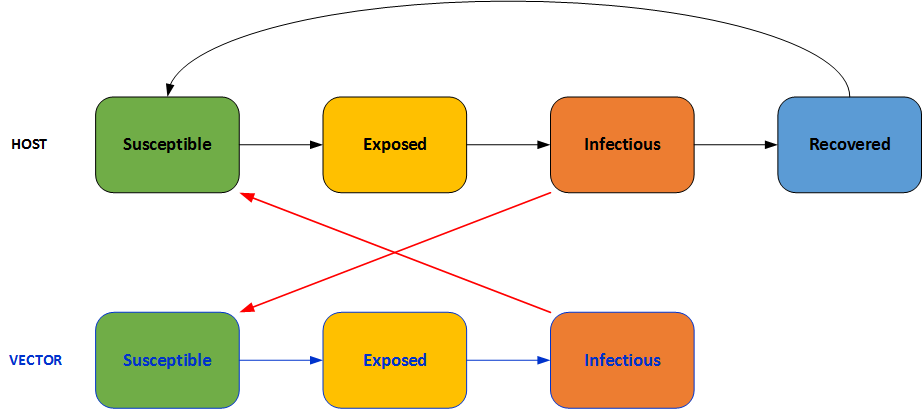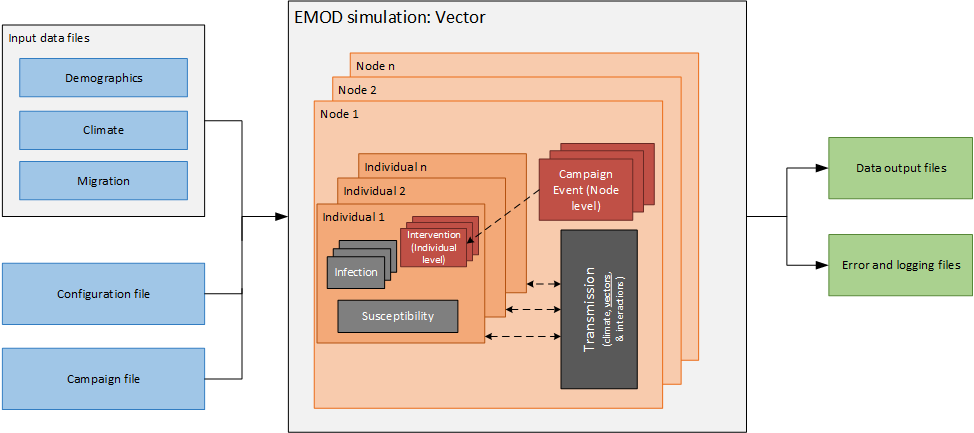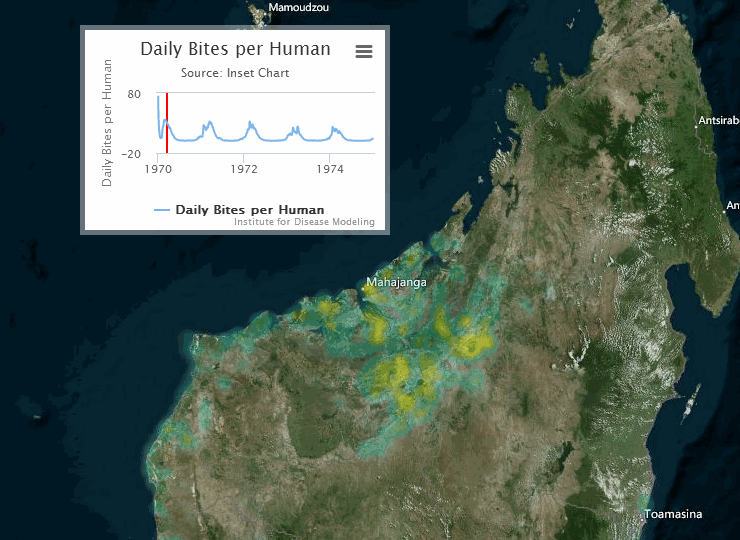Vector biology#
The EMOD vector model inherits the generic model functionality and introduces vector transmission and mosquito population dynamics. Interventions can be deployed within simulations for a variety of transmission settings with different transmission intensities, vector behaviors, and seasonally-driven ecologies. Climate data is necessary to simulate the effect of climatalogical impacts on vector biology. To use the vector model, set the configuration parameter Simulation_Type to VECTOR_SIM.
The figure below demonstrates the main components of the vector EMOD simulation type.

Vectors add a level of complexity to the interactions, as pathogens are transmitted via vector - human - vector. For a vector-borne disease, the SEIR model would appear as follows.

While EMOD is an agent-based model, both the simulated humans and vectors move through the various infection states analogously to the compartmental model illustrated above.
The core of the simulation consists of solvers for mosquito population dynamics and pathogen transmission to and from the human host population. While the human population is fully individual-based, the mosquito population can be represented by discrete cohorts or individual agent mosquitoes. As an agent-based model, interactions between humans and vectors advance during each time step. The mosquito population is advanced, for example, through discrete 1-day time steps during which mosquitoes may engage in host-seeking or feeding behaviors, mating, maturation through a life-stage, or even death. Successful feeds on humans can result in infection of the human host, or conversely, susceptible mosquitoes may become infected from an infectious human.
Model implementation structure#
There are two categories of possible implementations of the basic model, each with different computational efficiencies, resolutions, and flexibilities. The first is an individual model, where it simulates every individual mosquito in the population or can utilize a sampled subset of mosquitoes to represent the population as the whole. The second is a modified cohort simulation, with or without explicit mosquito ages.
Individual mosquito model#
This basic model can be implemented through simulation of every individual mosquito, or by simulation of a subset of individual mosquitoes to represent the full population. Each mosquito’s state contains status (susceptible, latently infected, and infectious), timers for transition to adult from immature and infected to infectious, mating status and Wolbachia infection, and age. An oviposition timer to enforce a fixed feeding cycle may be included as well. If mosquitoes are sampled and a subset used to represent the local population, each sampled mosquito will have an associated sampling weight as well. To use this model, set the Vector_Sampling_Type parameter to TRACK_ALL_VECTORS or SAMPLE_IND_VECTORS. See Sampling parameters for more information.
Cohort model#
In the modified cohort simulation, rather than representing the entire population by three compartments for susceptible, latently infected, and infectious mosquitoes, the simulation dynamically allocates a cohort for every distinct state, and the cohort maintains the count of all mosquitoes in that state. For the cohort simulation with explicit ages, in order to allow modeling of senescence, mosquito age is part of the state definition, and many more cohorts are required to represent the population. To use this model, set the Vector_Sampling_Type parameter to VECTOR_COMPARTMENTS_NUMBER or VECTOR_COMPARTMENTS_PERCENT. See Sampling parameters for more information.
Spatial-scale dynamics and migration#
Extensive multi-node simulations with location-specific climate, intervention deployments, larval habitat, and migration may be configured within the EMOD framework. Nodes can be configured to best represent the spatial scale being simulated: a node can be at the household level, village level, county level, national level, or other desired geographic scale. Migration can be enabled between nodes (for both humans and mosquitoes), such that EMOD can most accurately represent the dynamics of the location. By varying spatial-scale resolution, relevant factors for transmission dynamics can be more clearly elucidated. For information on configuring nodes and migration parameters, see Migration.
The following visualization shows an example of a gridded representation of malaria transmission on the island of Madagascar.

The following pages in this section describe the structural components of the vector model.
